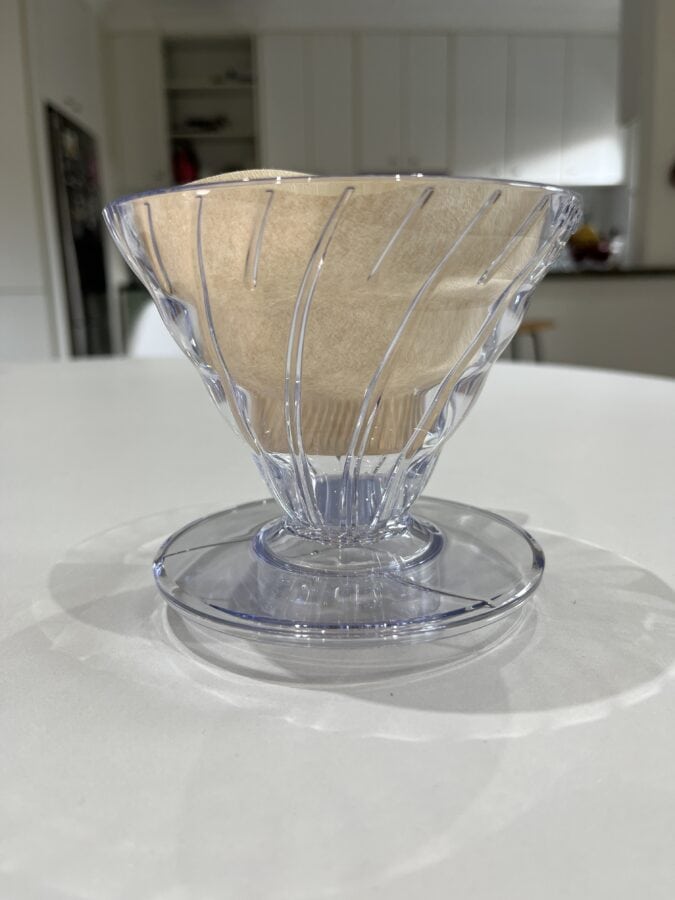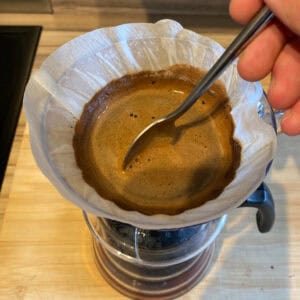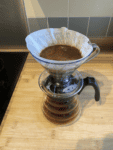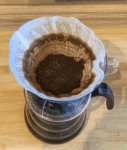Should You Use Bleached or Unbleached Paper Coffee Filters?

Table of Contents
ToggleIn the pursuit of the perfect cup of coffee, the choice between bleached and unbleached paper coffee filters may seem trivial. Pour over coffee may seem like a straightforward way to make a delicious cup of joe, but even the paper filters you use can make a difference to the overall taste.
There is often debate amongst coffee lovers as to whether bleached or unbleached paper filters are best when using traditional pour over coffee makers such as the V60, Chemex, Melitta or Kalita. In this article, we’ll explore the main differences between bleached and unbleached paper filters, and weigh up which is best for you. There are more factors at play than just taste, as the paper filter you choose has an impact on the environment as well.
What is Pour Over Coffee?
Paper filters are typically used to make pour over coffee.
Pour-over coffee is a manual brewing method that involves pouring hot water over coffee grounds contained in a filter. This process allows for precise control over brewing variables such as water temperature, pour rate, and extraction time, resulting in a clean, flavorful cup of coffee.
Pour over coffee differs from drip brewed coffee, as it is a manual method of extracting coffee oils from the grounds. On the other hand, drip brewed coffee is made using an automatic machine that does all the coffee extraction for you at the push of a button.
Compared to immersion coffee brewing like the French press or cold brew, and pressurised brewing like espresso, pour over coffee requires specific technique.
Pour over coffee methods like the V60 and Chemex require careful preparation and technique to get the best out of them. Whilst they can be difficult to master, these coffee brewing methods are also very rewarding when you get them right. There is a certain ritual to pour over coffee that enthusiasts and aficionados love.
Why Use Paper Filters?
Paper filters play a crucial role in pour-over coffee brewing by trapping coffee grounds and sediment while allowing the flavorful oils to pass through into your cup. These filters offer a cleaner and brighter cup of coffee compared to metal or cloth filters, which tend to allow more sediment to pass through.
Pour over coffee uses paper filters to slow down the flow of coffee into the cup, ensuring you get a full and even extraction as hot water passes over the medium ground coffee.
Paper filters offer a very fine filtration which limits the amount of sediment that will end up in your cup. This differs from metallic mesh or cloth filters, that are typically used in devices like the French press and Moka pot.
The use of paper filters means you’ll get a very clean, pure and fresh tasting cup of coffee, compared to the more robust, full bodied and viscous coffee that mesh or cloth filters produce.
Bleached vs Unbleached Paper Filters
The hot debate when it comes to pour over brewing, is whether you are best off using bleached or unbleached paper coffee filters.
You can easily tell the difference between bleached and unbleached paper coffee filters just by looking at them. Bleached filters are bright white in colour, whereas unbleached filters are natural brown looking.
Bleached filters tend to offer a cleaner flavour, whereas unbleached paper filters can sometimes leave a lingering papery aftertaste. However, bleached paper filters (particularly those that use chlorine) tend to be less environmentally friendly than natural, unbleached papers.
In a nutshell, the primary difference between bleached and unbleached paper filters lies in the impact on taste and environmental sustainability. This is where coffee enthusiasts need to consider the trade off they may be making between a potentially superior tasting cup of coffee, and the lasting environmental impact this may cause.
How Are Paper Filters Bleached?
Paper filters can be bleached using either chlorine or oxygen-based methods.
Chlorine bleaching involves the use of chlorine compounds, which can potentially leave trace chemicals in the filter and impact the environment. This, coupled with the additional processing and energy expenditure required for bleaching to take place, gives bleached paper coffee filters a reputation for being less environmentally friendly.
In fact, according to Purely Paper’s Environmental FAQ section, chlorine used to bleach paper filters can have a detrimental impact on water quality and aquatic life.
Further to this, a 2012 study in the Environmental and Engineering Management Journal found that chlorine bleaching produces pollutants such as “air emissions, dissolved material, residual chemicals (and) wastewater” and “large quantities of solid wastes and sludges are also generated”.
Oxygen-based bleaching, on the other hand, relies on natural oxygen compounds and is considered more environmentally friendly. This method uses sodium percarbonate and hydrogen peroxide to remove stains when in contact with water.
Whilst the oxygen bleaching method of whitening paper filters is more arguably environmentally friendly than the chlorine based method, both require more energy, processing and labour than forgoing bleaching altogether.
Key Differences Between Bleached and Unbleached Paper Filters Explained
Other than the obvious colour differences between bleached and unbleached coffee filter papers, there are also environmental and flavour impacts that need to be considered.
Here is a table summarising the key differences between bleached and unbleached filter papers used for pour over coffee. This includes the impact of each on taste, colour and the environment.
| Category | Bleached Papers | Unbleached Papers |
| Taste | No noticeable taste | May impart a slight papery taste to the coffee |
| Colour | Bright white | Natural Brown |
| Environmental Impact | May contain trace chemicals from the chlorine bleaching process. Also requires more energy to produce | Minimal environmental impact, easily recyclable/compostable |
How to Remove or Mitigate the ‘Papery’ Taste
Whether you are using bleached or unbleached paper coffee filters, you can mitigate or even remove that unpleasant papery taste altogether.
Whilst unbleached paper filters have more or a tendency to carry a distinctive paper flavour than bleached filters, this can be reduced greatly by wetting the papers with hot water.
Letting hot water soak through the entirety of your paper filter (bleached or unbleached) will pretty much eliminate any lingering paper taste that may otherwise be present.
You may need to rinse through twice for thicker unbleached papers, but nonetheless this should do the trick.
Make sure to discard the water before brewing your coffee though!
Tips to Improve Your Pour Over Experience
Here are a few more top tips to level up your pour over coffee game.
- Use freshly ground coffee beans for optimal flavour.
- Pre-rinse your paper filter to remove any paper taste and preheat your brewing vessel.
- Experiment with different grind sizes, water temperatures, and pouring techniques to find your perfect brew.
- Aim for a medium grind size that is slightly coarser than you think you’ll need, and then dial it down from there to avoid astringent or overly bitter coffee.
- Make sure to bloom your coffee grounds with a small amount of water before brewing, to degas the coffee and open up their natural flavours.
Popular Pour Over Coffee Makers Explained
V60
Features a cone-shaped dripper with spiral ridges for optimal extraction. The V60 is a very versatile coffee maker that can accommodate many different coffee bean origins, roast profiles and flavour preferences.
Chemex
The Chemex is an hourglass-shaped glass vessel that uses a thick paper filter for a clean and sediment-free cup. It works best with medium to light roasted coffee and requires careful preparation and technique to achieve even coffee extraction.
Clever Dripper
The Clever combines immersion and drip brewing methods, offering easy and consistent brewing without the fuss. It is a very forgiving coffee maker that can be customised to the user’s preferences.
Melitta
A versatile and accessible coffee maker that features a cone-shaped filter holder and paper filter for straightforward brewing.
Other Coffee Brewing Methods That Use Paper Filters
Aeropress
The Aeropress is a premium portable coffee maker that utilises a small, round paper filter. Aeropresses combine immersion and partial pressurised coffee brewing to deliver a rich, smooth and intense drinking experience.
Espresso
Espresso portafilters can sometimes use a paper filter or metal mesh puck screen to optimise extraction. This helps water flow more evenly through the tightly packed, finely ground coffee puck, helping coffee extraction occur more evenly.
French Press
Whilst the French press tends to use a metal mesh filter, paper filters can also be used to offer a smoother drinking experience when plunging. Uses a metal mesh filter for immersion brewing.
Moka Pot
Whilst it is not necessarily recommended, Aeropress style paper filters can be used to offer a different texture to Moka pot coffee.
Different Types of Coffee Filters
While this article focuses mainly on paper coffee filters, other materials can also be used to keep ground coffee from entering your cup.
Paper
Offers a clean and bright cup with easy disposal after use. Removes virtually all ground coffee sediment.
Cloth
Cloth filters are sustainable and arguably quite eco friendly. However they can be very difficult and messy to clean and also tend to have inconsistent results.
Metallic Mesh
Used in automatic drip brew machines, French presses and Moka pots, mesh filters allow some silt and sediment to slip through the net. This often results in a fuller bodied, thicker cup of coffee as oils and sediment to pass through for a richer cup.
Paper Filter Summary
Overall, the key differences between bleached and unbleached coffee paper filters lie in their impact on the environment and the taste they transfer into the cup.
Whilst rinsing your paper filters with hot water before using them can dispel most of this papery taste, there can sometimes still be a lingering aftertaste present, particularly with unbleached papers.
Paper filters offer a convenient and effective way to brew pour-over coffee, providing a clean and flavorful cup with minimal sediment. Whether you choose bleached or unbleached filters depends on your personal preferences and environmental considerations.
Bleached and Unbleached Filter Papers Frequently Asked Questions
While some people reuse paper filters to reduce waste, it may affect the flavour and quality of your brew.
Unbleached filters are generally considered more environmentally friendly due to the absence of chlorine bleaching chemicals.



